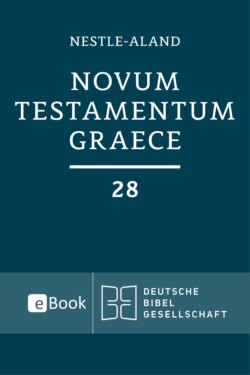Читать книгу Novum Testamentum Graece (Nestle-Aland) - Группа авторов, Nestle-Aland - Страница 38
INTRODUCTION I. THE EDITION 1. History of the Edition
ОглавлениеIn 1898 Eberhard Nestle published the first edition of his Novum Testamentum Graece. Based on a simple yet ingenious idea it disseminated the insights of the textual criticism of that time through a hand edition designed for university and school studies and for church purposes. Nestle took the three leading scholarly editions of the Greek New Testament at that time by Tischendorf, Westcott/Hort and Weymouth as a basis. (After 1901 he replaced the latter with Bernhard Weiß's 1894/1900 edition.) Where their textual decisions differed from each other Nestle chose for his own text the variant which was preferred by two of the editions included, while the variant of the third was put into the apparatus.
The text-critical apparatus remained rudimentary in all the editions published by Eberhard Nestle. A primary apparatus displayed as witnesses only the editions mentioned above, while a second apparatus initially contained only readings from Codex Bezae. Subsequently evidence from other important manuscripts was added. It was Eberhard Nestle's son Erwin who provided the 13th edition of 1927 with a consistent critical apparatus showing evidence from manuscripts, early translations and patristic citations. Now the “Nestle” met the standards of a scholarly hand edition of the Greek New Testament. However, these notes did not derive from the primary sources, but only from editions, above all that of von Soden.
This changed in the nineteen-fifties, when Kurt Aland started working for the edition by checking the apparatus entries against Greek manuscripts and editions of the Church Fathers. This phase came to a close in 1963 when the 25th edition of the Novum Testamentum Graece appeared; later printings of this edition already carried the brand name “Nestle-Aland” on their covers.
The 26th edition, which appeared in 1979, featured a fundamentally new approach. Until then the guiding principle, with very rare exceptions, had been to adopt the text supported by a majority of the critical editions referred to. Now the text was established on the basis of source material that had been assembled and evaluated in the intervening period. It included early papyri and other manuscript discoveries, so that the 26th edition represented the situation of textual criticism in the 20th century. Its text was identical with that of the 3rd edition of the UBS Greek New Testament (GNT) published in 1975, as a consequence of the parallel work done on both editions.
Already in 1955 Kurt Aland was invited to participate in an editorial committee with Matthew Black, Bruce M. Metzger, Alan Wikgren, and at first Arthur Vööbus, later Carlo Martini (and, from 1982, Barbara Aland and Johannes Karavidopoulos) to produce a reliable hand edition of the Greek New Testament for the specific needs of Bible translators.
The first edition of the GNT appeared in 1966. Its text was established along the lines of Westcott and Hort and differed considerably from Nestle's 25th edition. This holds true for the second edition of the GNT as well. When the third edition was prepared by Kurt Aland, Matthew Black, Carlo Martini, Bruce Metzger and Alan Wikgren, Kurt Aland was able to contribute the textual proposals coming from his preliminary work on the 26th edition of the Nestle-Aland. Hence the process of establishing the text for both editions continued to converge, so that eventually they could share an identical text. However, their external appearance and the design of their apparatus remains different, because they serve different purposes. The GNT is primarily intended for translators, providing a reliable Greek initial text and a text-critical apparatus showing variants that are relevant for translation. In the case of the passages selected for this purpose the evidence is displayed as completely as possible. The Novum Testamentum Graece is produced primarily for research, academic education and pastoral practice. It seeks to provide an apparatus that enables the reader to make a critical assessment of the reconstruction of the Greek initial text.
The text of the 26th edition of the Nestle-Aland was adopted for the 27th edition also, while the apparatus underwent an extensive revision. The text remained the same, because the 27th edition was not “deemed an appropriate occasion for introducing textual changes” (NA27, p. 45*). Since then the situation has changed, because the ECM of the Catholic Letters is now available. Its text was established on the basis of all the relevant material from manuscripts and other sources. The ECM text was adopted for the present edition following approval by the editorial committee of the Nestle-Aland and the GNT.
